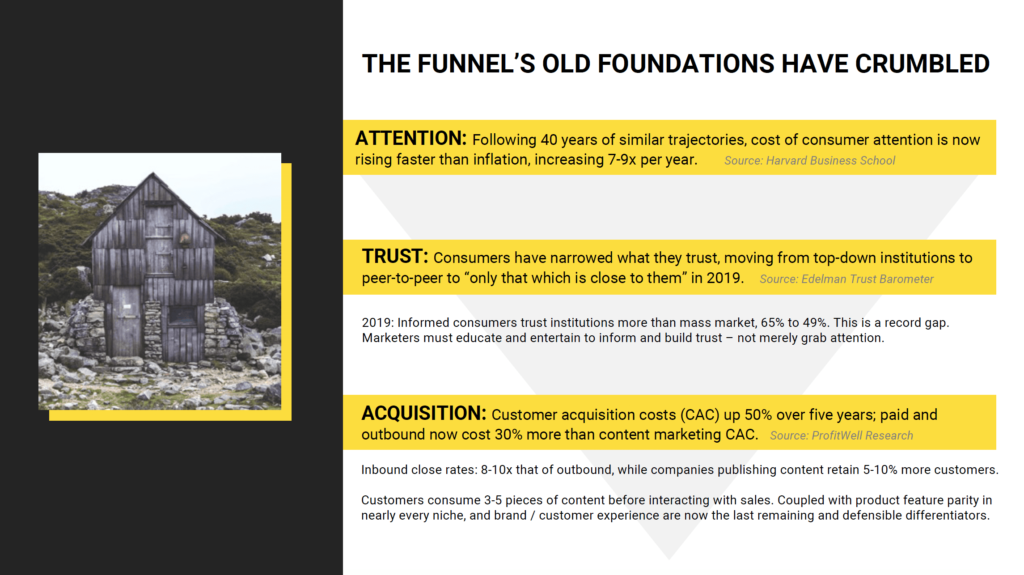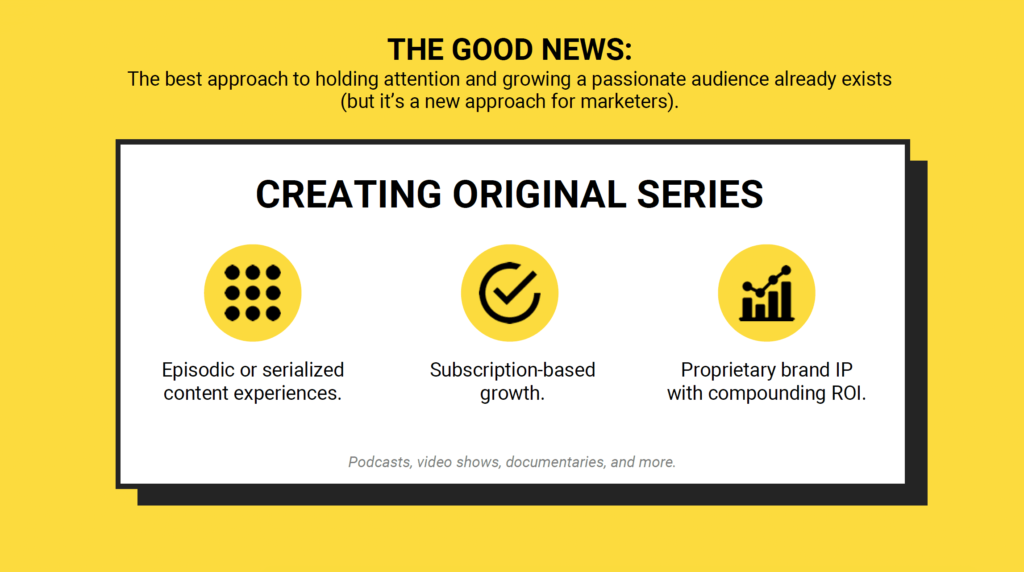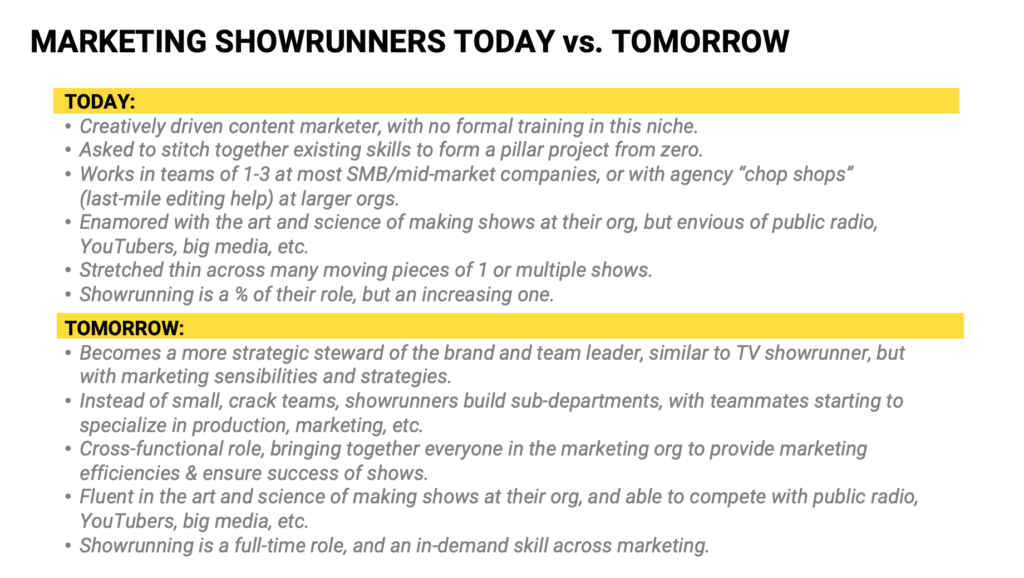About Marketing Showrunners
We serve marketers who want to find & share their voice, make a difference, and shift the culture of their industries for the better. We believe a show is the best way to do so.
💛 Our Core Belief:
Marketing isn’t about who arrives. It’s about who stays.
🤝 Our Audience:
We serve marketers who view their jobs as something greater than simply selling more stuff. They see that as a byproduct of what they really do: serve their audiences. So we in turn serve those marketers — people who want to find and share their voice, make a difference, and shift the culture. We’re fortunate to work with a wide range of marketers who receive our content and education. They come from big brands like Red Bull, Adobe, Salesforce, and Shopify, to fast-risers like Mailchimp, Wistia, and Roku, to media like the New York Times and Amazon Prime, to thousands of SMBs and startups.
Why marketers like you should be thinking about making original shows:
Let’s go Chicken Little on the marketing industry for a moment, shall we? Because taken the wrong way, most observations and studies about our industry seem to make it feel like the sky is falling. However, CMOs now face the single-biggest opportunity we’ve encountered in the digital age as marketing leaders, if only we’d actually identify and discuss the opportunity at hand instead of couching it in jargon … or panicking too much to see it at all.
But before we address the opportunity, let’s embrace the panic a bit, just for … fun?
The funnel’s foundations have crumbled.
According to a report from Harvard Business School, after 40 straight years of the rising cost of consumer attention matching inflation, things have gotten out of hand. Cost of consumer attention is now rising 7-9x per year, far outpacing inflation in the US. (Insert obligatory “noisy world” quip here.)
If we still manage to grab attention at the top of the funnel, our need to turn attention into trust — aka the middle of the funnel — still triggers some cold sweats. Consider Edelman’s annual Trust Barometer. As the report … um … reports … we’re experiencing a radical narrowing in what consumers trust over recent years. It used to be the case that people trusted large institutions with lots of power. That understandably gave way to peer-to-peer trust, albeit a sort of loosely held type of connection with social media. That once again gave way to an understandable narrowing, as today, we trust “only that which is close to us.” This includes actual friends, family, and notably for B2B marketers, colleagues. The bottom line: without firsthand experiences and significant time invested with a brand, the consumer doesn’t trust its marketing enough to take action.
The feather-raising news continues for Chicken Little Marketers. Moving from initial awareness (too expensive!) to building trust (too time consuming!) to now the bottom of our funnels, where we need to convert actual paying customers, we can once again shriek about cost.
According to a report studying the data of several thousand software companies by ProfitWell, CAC is up 50% over the last five years, while paid and outbound acquisition channels are now 30% more expensive than content marketing approaches. That may seem like good news for content-centric brands, until you consider the difficulties we just reviewed in acquiring attention and earning trust. (That doesn’t make it any less necessary, mind you: Edelman’s Trust Barometer notes the historically wide gap between the percent of consumers who trust brands when they’re well-educated as compared to the mass market: 65% versus 49%. Despite increasing difficulty, we marketers still need to reach others with our content and earn trust through it.)
Again: Chicken Little, meet marketing. The case can easily be made that our sky is falling.
I’d like to make a different case, however. I believe we face the single-best opportunity for career success as marketing leaders AND company growth, and we can achieve both in a way that audiences genuinely enjoy.
CMOs: It’s time we looked truth in the face
I don’t know about you, but I sometimes feel like most marketers act like Sansa trapped in the crypts at Winterfell in Game of Thrones. The dead are attacking, and there goes another marketer who claims, “I can’t do anything about what’s going on out there. The most heroic thing we can do now is look that truth in the face.”
Okay, fine: Let’s look the truth in the face. The question isn’t whether or not things have changed. The question is: What are we doing about it?
See, the truth is, our mandate must change along with the world. In fact, our mandate has already changed. We just aren’t talking about it enough. We stop our discussions on the industry’s reactions to a fundamental shift in our work, rather than the shift itself. The reactions are things like content marketing, influencer marketing, social media marketing, and the like. But let’s focus for a moment on the first principle itself, so we can build back up more original thinking from there:
Marketing is no longer about grabbing attention. It’s all about holding it. Today’s best marketers understand: Marketing isn’t about who arrives. It’s about who stays.
When we look that truth right in the eye, and execute accordingly, we reap two huge rewards with our marketing:
1. We increase the lifetime value (LTV) to our brands of everyone we reach.
2. We decrease our customer acquisition costs (CAC) thanks to word of mouth.
Just think: If our funnels were more efficient — if we could straighten them instead of merely dump more into the top, and if we could lose fewer people down through the funnel — wouldn’t our results grow? “Growth,” after all, doesn’t just mean “bigger topline numbers.” Growth, as anyone managing a subscription business will tell you, means getting bigger results with less. It means retained and happy customers for our products and, in marketing, retained and happy audience for our content.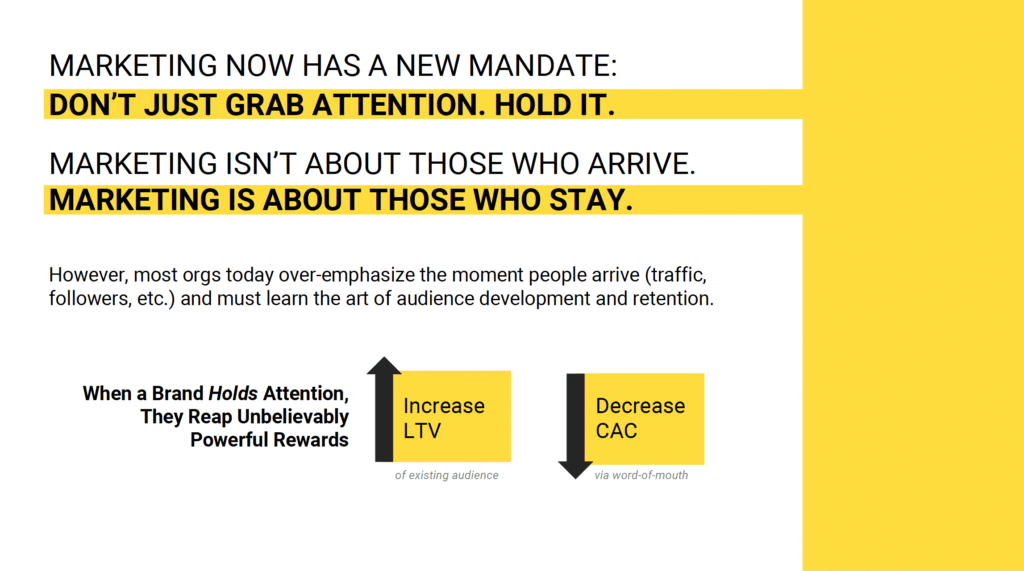 If we were built to grow a passionate audience, instead of obsess over first- and last-touch marketing only, we’d need fewer people in our funnel, as we’d increase the odds that someone we reached eventually purchased. In a world where attention has become more expensive, that’s great news! I mean, what are we doing as leaders if not trying to do more with less? But “doing more with less” doesn’t mean running the same playbook with fewer resources. It means doing more with less waste. It means convincing a larger percentage of those we reach to stick around.
If we were built to grow a passionate audience, instead of obsess over first- and last-touch marketing only, we’d need fewer people in our funnel, as we’d increase the odds that someone we reached eventually purchased. In a world where attention has become more expensive, that’s great news! I mean, what are we doing as leaders if not trying to do more with less? But “doing more with less” doesn’t mean running the same playbook with fewer resources. It means doing more with less waste. It means convincing a larger percentage of those we reach to stick around.
Speaking of reaching people, when our marketing does the seemingly magical work of holding attention, not merely acquiring it, we also lower CAC over time. The people who invest their precious time with us become happy and passionate customers. Happy and passionate customers create word of mouth, especially when the things triggering their happiness and their passion is a wonderful brand experience.
So how do we capitalize on this opportunity? A handful of early, enterprising marketing teams are well on their way to doing so, — teams at brands like Mailchimp, Facebook, Marriott, Shopify, Andreessen Horowitz, MasterCard, Bank of America, Buffer, Help Scout, Podia, Basecamp, InVision, Drift, and Wistia.
These and others like them are starting to focus their marketing efforts on one of the most proven, audience-centric approaches to holding attention ever invented: the original series.
The rise of the marketing showrunner
When we create original series in any medium, from podcasts to documentary series to video shows, we hasten the trust people develop with us. Shows are built with the express goal of holding attention. While they provide discrete benefits at various parts of the buyer’s journey, shows don’t necessarily sit anywhere in the funnel. Instead, shows straighten the entire damn thing. They’re like adding an accelerant to our funnel. By holding attention, we can turn passive “awareness” into active trust and vocal passion more effectively and efficiently.
Shows are trust accelerates. Shows aid funnel velocity. Shows, I believe, are an entirely new way of doing marketing, better suited for this era than the bygone days of merely “grabbing” attention.
Through these subscription-based, serialized and episodic content, we can develop proprietary brand IP that builds a moat around our brands. Copy a blog post of ours, and a competitor can’t be accused of much. Try to do anything at all involving the themes our shows claim, and they’re almost doing our marketing for us.
The same ProfitWell report I cited early shows that people consume three to five pieces of content before talking to sales — let alone buying direct from any B2B or B2C company. Up until this point, we mostly believed that our marketing was about providing those three to five moments of content consumption via separate, disconnected but loosely related pieces. But “subscribe to get more like this” is far less powerful than “subscribe to get Episode 2” or “to see what happens next!”
Calls-to-action and other tactics aside, providing a series rather than disconnected pieces or messages shifts our marketing’s very foundation to better match the times. We emphasize getting people to stay, so that anyone who arrives is more valuable to our brands (higher LTV) and more likely to spread what we do to others (lower CAC).
“We’re at a moment of transition for narrative,” said Joe Russo recently. Joe Russo is one half of the vaulted Russo brothers in Hollywood, along with Anthony. Together, they’ve directed four Marvel movies, including the record-shattering Avengers: Endgame, as well as several episodes of the shows Community and Arrested Development.
So what’s with this “moment of transition for narrative,” according to Joe?
“(Consumers) have a PhD in content consumption. They want serialized storytelling because they like that emotional connectivity, and also what that serialized storytelling gives them, which is conversation.”
Translation: LTV goes up. CAC goes down.
If you’re drooling, I understand. This feels like Holy Grail stuff for marketers. (Maybe the sky isn’t falling so much as filling up with angels singing…)
Big Media already understands the need to hold attention, not just grab it. They’re racing for original series, hiring showrunners from all corners of movies and TV to execute their vision. Netflix spent $12b in 2018 and Amazon $7b, while Disney, Showtime, and HBO all dumped more into creating originals than ever before. In the world of audio, Spotify says it will spend more than $500m on acquiring companies, including the recent, splashy news that they’ve purchased Anchor (the platform aiming to democratize podcast creation) and Gimlet Media (the premium, narrative-style podcast production company).
What big media does now, brands tend to do next. However, given the list of companies I mentioned earlier who are either launching standalone series or, for some, entire show networks and teams, we’re already witnessing the rise of marketers making shows.
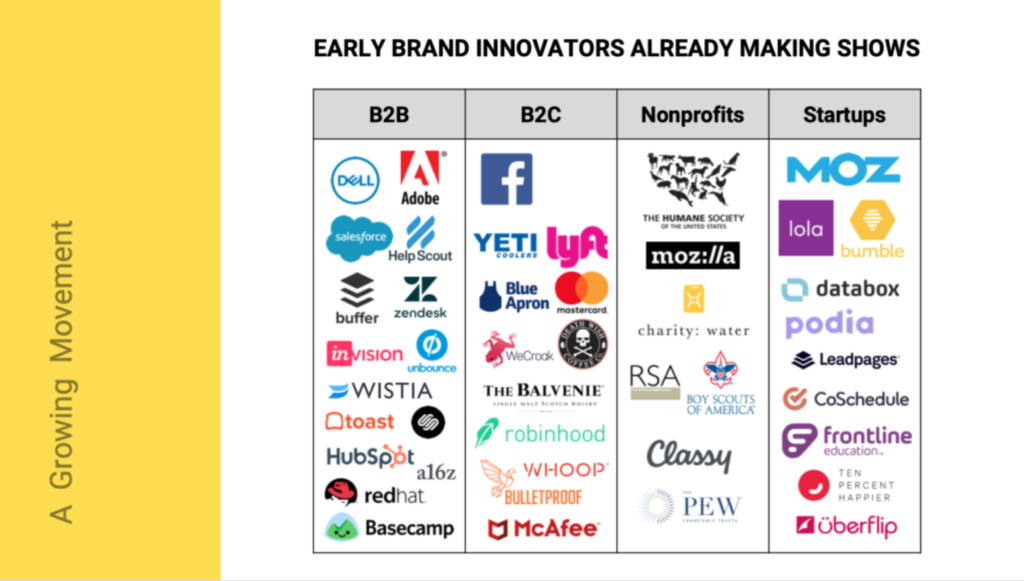
Along with our new mandate as marketers comes a new type of marketer uniquely suited to lead and execute: the marketing showrunner.
One part strategist, one part creator, one part marketer, all parts essential
In the world of TV, showrunners are like mini-CEOs on their series. They’re the individuals with creative authority and management responsibility over the people, processes, and budgets relating to creating and growing their shows.
Like anyone in the marketing department, from the CMO to the interns, a traditional showrunner reports to and works with others who have a vested interest in their work. They must understand the overall values of their networks, meet certain audience goals for their shows, work alongside sales to talk revenue, and more. Unlike most people in marketing departments, however, the showrunner trades in serialized and episodic content, not “pieces.” They believe in holding attention to grow passionate audiences above all else.
What if we did too?
My firm belief is that, within a year, we start to see the title “showrunner” popping up on the most modern marketing teams in the world. These individuals will occupy several crucial roles for their companies:
– Crafting the business case for one or more shows at a brand.
– Managing all parties, including freelancers, agencies, and in-house creators and marketers responsible for delivering quality product to the world.
– Stewarding the growth of a series or network of series.
– Brokering high profile deals with distribution platforms (e.g. Spotify, YouTube) and ongoing relationships with co-marketing partners, on-air and on-camera talent, and, internally, cross-functional teams.
– As needed, concepting and developing pilots and full-fledged original series.
– As needed, writing, producing, directing, and hosting.
Today, hundreds if not thousands of marketers are operating as showrunners already, despite their titles sounding more broad, like VP of Marketing or Director of Content or Podcast Producer or Content Marketer.
These showrunners largely operate in silos or small teams, and they’re asked to stitch together skills picked up from other loosely related jobs or tasks, in order to create what should be a pillar project from zero. Creating and growing shows is a small but increasing percentage of their overall jobs.
Likewise, the shows themselves are often not central to a brand’s marketing strategy. This is a mistake. Shows SHOULD be a massive exercise in brand IP development, uniting teams and rallying audiences around key themes in the market. They SHOULD provide endless marketing efficiencies across the funnel, both due to the aforementioned trust acceleration with audiences, and by providing infinite content to syndicate, repackage, and repurpose. They SHOULD be built by discrete teams with dedicated budgets and leaders (and they are, at some brands like Mailchimp, Shopify, Wistia, and ProfitWell).
But largely, shows are still side projects. We’re in the early adopter phase of this new approach to marketing. We’re about a year away before this explodes — which, for the innovative, forward-looking CMO, is exactly when you want to start investing heavily. (BTW, for all these reasons, and after creating 10+ original series with brands, I launched Marketing Showrunners to provide regular insights and inspiration for marketing execs on the forefront of this movement.)
More than ever before, marketers must focus their time on what happens after someone arrives. That will require a shift in thinking, sure, but it will also lead to a shift in where top talent focuses their time — and what titles they hold, too.
Ask yourself and your team: What are we doing to ensure people stay, not just arrive?
Make your audience an irresistible offer. Give them something worth returning for, something worth investing significant time into consuming. Ask them to subscribe with a purpose, because they can’t miss what happens next or can’t wait to go deeper with you next time. Once they arrive, give them a real reason to stay.
Don’t just grab attention. Hold it. Don’t just make some “pieces.” Make a show.
Remember: Marketing isn’t about those who arrive. Marketing is about those who stay. In a world of so many Chicken Littles screaming that our world is coming to an end, I hope you see the big opportunity at hand. Unlike what Sansa experienced in Game of Thrones, looking this particular truth in the face is not a “heroic” thing to do. For marketing leaders today, it’s simply the job.
Welcome to the era of the marketing showrunner.
 JAY ACUNZO
JAY ACUNZO
Founder, Marketing Showrunners
e: jay@mshowrunners.com
t: @jayacunzo
IG: @jacunzo



